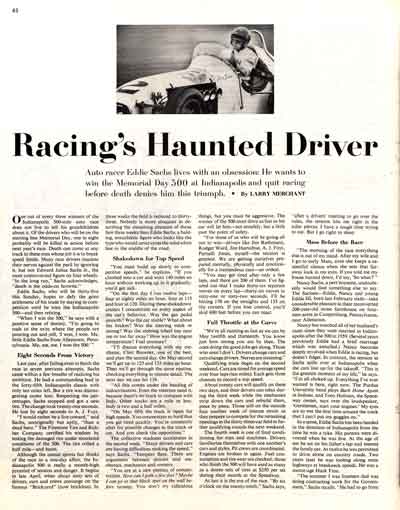Racing’s Haunted Driver Eddie Sachs
In a 1962 Post article, “Racing’s Haunted Driver,” champion racer Eddie Sachs described to writer Larry Merchant the thrill he felt as he lined with the other drivers at the Indianapolis 500: “This is the greatest moment of my life,” Sachs says. “I’m all choked up. Everything I’ve ever wanted is here, right now. The Purdue University band plays Back Home Again in Indiana, and Tony Hulman, the Speedway owner, says over the loudspeaker, ‘Gentleman, start your engines.’ My eyes are so wet the first time around the track that I can’t put my goggles on.” (See full article below.)
The excitement is still there for the 33 racers and the hundreds of thousands of spectators who, on May 25th, will attend the 98 annual Indianapolis 500—the 69th consecutive running of this spring classic.
Any tradition honored for so long is bound to stir emotions. The Indy 500 is a particularly emotional event because it brings together high-risk sports, the latest technology, and continual fast action.
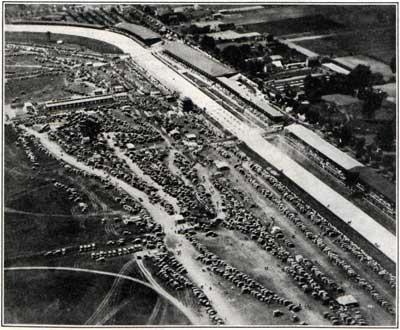
When the Post interviewed Eddie Sachs just weeks before the race, he was optimistic that he would finally achieve his lifetime dream of winning the 500. “The previous year (1961), after failing even to finish the race in seven previous attempts, Sachs came within a few breaths of realizing his ambition. He had a commanding lead in the 45th Indianapolis classic with only 10 miles left. But a tire was disintegrating under him. Respecting the percentages, Sachs stopped for a new tire. The change took 21 seconds. He lost by eight seconds to A. J. Foyt.”
Eddie Sachs was as determined to win as ever, but he was reducing his vulnerability. “One of every three winners of the Indianapolis 500-mile auto race does not live to tell his grandchildren about it. Of the drivers who will be on the starting line Memorial Day weekend, one in eight are likely to be killed in action before next year’s race. Death can come at any track to these men whose job it is to break speed limits. Many race drivers insulate their nerves against the peril by ignoring it, but not Edward Julius Sachs Jr., the most controversial figure on four wheels. ‘In the long-run,’ Sachs acknowledges, ‘death is the odds-on favorite.’
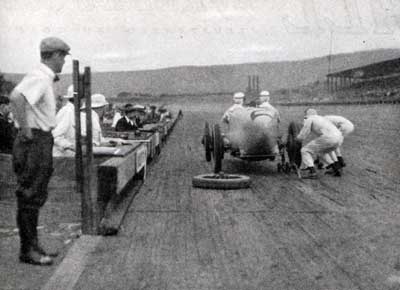
“Eddie Sachs, who will be 35 this Sunday, hopes to defy the grim arithmetic of his trade by staying in competition until he wins the Indianapolis 500—and then retiring,” reports the Post article. “In [his] younger, wilder days, Sachs raced as often as 200 times a season. This year—if he is frustrated at Indianapolis again—he will appear in only five major events and a handful of stock-car races. By driving only the best cars on the safest tracks in a select few events, Eddie Sachs has reduced the odds against him. But every race is a risk. The question is—since his retirement plans hinge upon his winning at Indianapolis—will Eddie be able to stop in time to beat those deadly percentages?”
Two years later, Eddie Sachs was killed in a multiple-car collision in the second lap of the race. The accident prompted the U.S. Auto Club to limit the amount of gasoline each car could hold, and also encouraged the racing teams to switch to fuels using methanol and ethanol. This shift toward new fuels is another example of how Indianapolis is a proving ground for automotive innovations. Over the years, drivers have introduced several competitive innovations, which have been become standard features of the world’s cars: four-wheel brakes, independent suspension, high-mileage radial tires, fuel injection, and, of course, the rearview mirror.
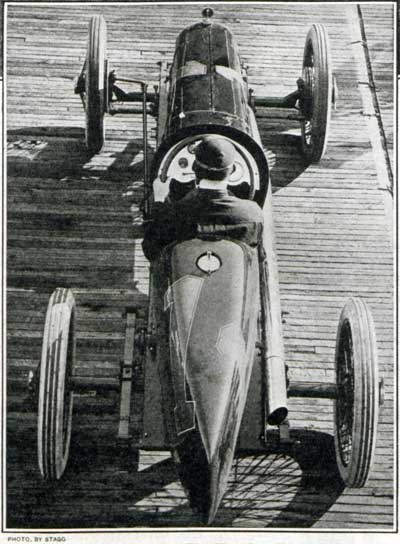
Like the family sedan, the Indy car has evolved from almost unrecognizable origins. In a 1926 Post article, “A View of Automobile Racing Through a Champion’s Eyes,” author William J. Sturm interviews Peter De Paolo, the 1925 A.A.A. title holder, who described how much the Indianapolis race had changed since its inception in 1911.
“Racing-car structure and racing practice are vastly different today from a few years back. One-man cars came into vogue at Indianapolis in 1923. It took a lot of the picturesqueness out of racing. The spectator no longer sees a mechanic sitting on the right of the driver, perhaps jerking vigorously at a pump to maintain the air pressure on the gasoline tank, or pumping oil into the crankcase of the car from the main reservoir, as was done in the old days.
“In those forgotten times the mechanic had a definite place in racing. It was his business to watch behind for the pursuing car. He gave the information to the driver at his side, who decided whether he should contest the passage of the pursuer or permit him to pass in peace. A long streamer or handkerchief was tied to the top of the racing helmet, its purpose being to furnish a cloth with which to wipe grime from goggles or face. When not being thus used it floated proudly behind and made a gallant display for the spectator.”
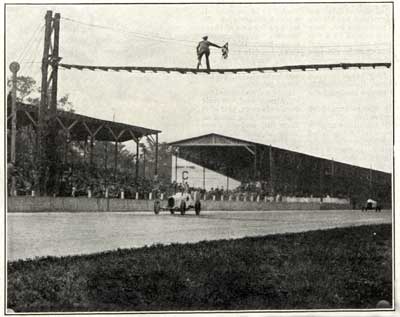
Despite the absence of helmet streamers, hundreds of thousands of race fans are expected to crowd the speedway and sing along with Jim Nabors when the band plays Back Home Again in Indiana.
The race begins at 1:00 p.m. on May 24th. Racers will circle the 2.5-mile track counterclockwise for 200 laps. Since the average speed of the winner will probably be between 140 and 150 miles per hour, the race should last about three hours and 30 minutes.
Speaking of horsepower …
Earlier this month, we listed the names of the horses in the Kentucky Derby and invited you to pick the winner with no further information. (Who would have chosen Mine That Bird based on the name alone?) Following this tradition, we present the names of the 33 drivers in Sunday’s race:
John Andretti, Marco Andretti, Stanton Barrett, Ryan Briscoe, Ed Carpenter, Helio Castroneves, Mike Conway, Scott Dixon, Robert Doornbos, Milka Duno, Sarah Fisher, Dario Franchitti, Davey Hamilton, Ryan Hunter-Reay, Tony Kanaan, Buddy Lazier, Alex Lloyd, Darren Manning, Raphael Matos, Vitor Meira, Mario Moraes, Hideki Mutoh, Danica Patrick, Nelson Philippe, Will Power, Graham Rahal, Tomas Scheckter, Oriol Servia, Scott Sharp, Alex Tagliani, Paul Tracy, E.J. Viso, Dan Wheldon, Justin Wilson
If you’d like to choose a favorite based on something more than a name, there’s plenty of information on the drivers and the event at indy500.com.
